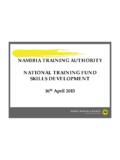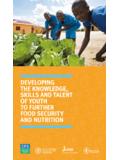Transcription of Bulembu Vocational Training Centre - Sahee
1 1 Bulembu Vocational Training Centre _____ Project Summary 2 Table of Contents Executive Summary .. 3 1 Sector and Regional Context .. 5 Statement of Need .. 5 2 Project 7 Project History and Formation .. 7 3 Project Activities .. 8 Project 8 4 Results Based Management Table .. 10 5 Beneficiaries .. 14 Direct Beneficiaries .. 14 Indirect 15 6 Risk Management .. 17 Potential Challenges and Risks and 17 7 Environmental Analysis .. 19 8 Sustainability .. 21 9 Building Floor Plans and Elavations .. 23 10 Financials .. 25 3 Executive Summary The Bulembu Vocational Training Centre (VTC) is a new initiative that seeks to provide Swazi youth with market driven technical job skills and Training for the hospitality industry that will enable them to secure steady, well paying jobs in Swaziland and become productive members of society and the community.
2 The VTC will also provide personal and social competencies, and impart key skills and abilities required in working life both in rural and urban areas. The focus will be on providing short, hands-on competency based Training programs which equip trainees with skills , entrepreneurial acumen and productive competencies needed for employment in the economy. Development research shows that good quality, broad based and market responsive technical and Vocational education, Training and skills development (TVETSD) programs supply the skills and competencies that immediately respond to labor market demands and that drive growth in post-industrial economies.
3 Skilled labor is critical for its capacity to apply knowledge and technology to realized higher valued added productivity to which is the base for sustainable growth. By enhancing the skills base, the TVETD sub-sector can contribute to several of the Poverty Reduction Strategic Action Plan (PRSAP) pillars: empowering the poor to generate income, macroeconomic stability, growth acceleration, human capital development, improving the quality of life and fair distribution of the benefits of growth. 1 Over the last 15 years HIV/AIDS has spread throughout Swaziland at an alarming rate. It has had a detrimental effect on young professionals across the country.
4 Over the next 5 years, the Swazi government will spend 8% of GDP on Training in an attempt to repopulate professional fields with skilled workers. Today, industry leaders have identified that the biggest obstacle to the continued growth is the provision of market driven Training to offset the vast losses in the workforce, due to AIDS. The VTC will specialize in Training for the hospitality industry and international tourism. The tourism sector is one of the few growing industries in Swaziland which currently only has one formal place of Training , which only supplies 25 graduates every 3 years to the industry. Industry partners do nearly all Training in-house, working with staff that have little to no experience.
5 The curriculum being designed for The VTC is partially based on curriculums designed by the Hospitality Youth Initiative (HYI) and used throughout South Africa, especially in regards to Training preparations for the 2010 FIFA World Cup. The curriculum will include areas of focus to the hospitality industry such as: food preparation and culinary arts; food and beverage service; reception operations and services; accommodation operations and services; and, international tourism. Sub-set classes will also be foundational to the program which will focus on English proficiency, AIDS awareness, Entrepreneurship and Leadership Development. The Bulembu Vocational Training Centre participates directly in the fight against poverty and the stabilization of Swaziland society through its skill-development Training .
6 By providing students with relevant skills for employment and necessary entrepreneurial skills , employment is increased. HIV/AIDS prevalence rates are much 1 World Bank Report and Analysis 4 higher in youth groups that have dropped out of school and are unemployed. Increasing employment, therefore, is also supporting the fight against this pandemic. The overall objective of The VTC is to alleviate poverty and unemployment by providing Vocational Training and job-creation projects for unemployed young Swazi s - especially those from historically disadvantaged communities. The VTC is part of the overall vision for Bulembu .
7 The vision of Bulembu is to restore Bulembu to a vibrant, self-sustaining community. This vision for sustainability includes fostering the development of a new generation of emerging leaders through orphan care, education, health services and commerce. Bulembu has placed a strong emphasis on business development and supporting local entrepreneurs. Since 2006, Bulembu has generated nearly 600 jobs ranging from timber to honey, tourism, and administration. Students at The VTC will have the advantage of incorporating their studies into this vibrant business culture and strong leadership Training , which will enhance their holistic development. The VTC s sustainability plan and capacity building initiative sets an objective of becoming sustainable within its first three years of operation.
8 Alongside and in conjunction with The VTC will be a conference facility which will be promoted through the already existing Bulembu Country Lodge. Corporate partners will be sourced to assist in funding, Training relevancy and potential job placements. 5 1. Sector and Regional Context Statement of Need According to the IMF, close to 40% of Swaziland s 1 million citizens are unemployed and the CIA s Fact Book (2006) indicates that official government statistics show 55% of Swazi s aged 15-24 are chronically out of work yet while tens of thousands of youth enter the work force every year, few find employment. This low uptake is largely due to a mismatch between the skills required by industry and the outputs of the education system.
9 The two existing large centres of Vocational Training in Swaziland Vocational and Commercial Training Institute Matsapa (VOCTIM) and Swaziland College of Technology (SCOT) are underfunded and unable to meet market needs. The World Bank s survey on Swaziland s Technical and Vocational Education and Training skills Development (TVETSD) revealed that Swazi companies are experiencing difficulty in hiring qualified staff. 28% of employers stated this was due to a lack of Training provision and 29% said it was because of the low quality of the outputs of the current Training system. The World Bank also noted that TVETSD in Swaziland is currently supply driven, not demand driven.
10 Providers focus on entry level skills in traditional areas such as mechanics, automotive, electrical, building, commerce and sewing. They do not adequately cater to emerging areas such as services, tourism, USAID s TechnoServe s Tourism Industry Strategic Plan (2006) identified one of the largest barriers to the industry being no Training available for management or staff who have no prior experience. This situation is further exacerbated by the fact that, according to the Hotel and Tourism Association of Swaziland (HOTAS), the need for trained staff will double over the next 5 years, first and foremost because of the AIDS prevalence rate which is reducing available staff at an alarming rate.






